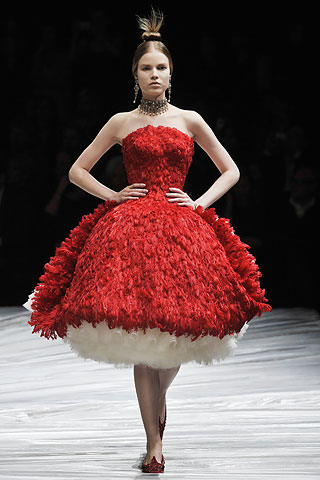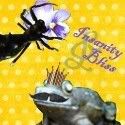The Sorbee region is unusual in its approach towards wine. The vines are grown among trees, thus changing the climate the grapes develop in dramatically from vines grown in open air. It is a young region. Plants average 35 years of age in Sorbee. The Vouette vineyard is a newer facility with vines ranging closer to 20 years. The wine maker only began his work in 2001, but he is already a cult figure in Champagne production. His facility is not only organic, but also bio-dynamic, the high level of chic in environmentally aware food production.
Melanie has read about the region recently. She is telling me what she knows about the grapes, and is excited to share a tasting set with me. Vouette has three tiers in their champagne quality. She has secured a bottle of each.
 9. Vouette et Sorbee Fidele Blanc de Noir Extra Brut
9. Vouette et Sorbee Fidele Blanc de Noir Extra BrutWe return again to a blanc de noir, all pinot noir. I am curious how the flavor will compare since I did not enjoy the last one.
The flavor is sweet and creamy. The wine is darker, a honey color. It tastes of peach, tart apples, and light oak flavor. There is sugar in the glass. In the mouth it tastes almost like candy, and the wine taste green, like it is still a bit too young. There is more acid in the texture than the last blanc de noir. For a base level champagne, it is interesting, but it is too candy for my liking. I would not buy it again.
Sometimes it is as if you can taste the gears the wine's been through. Like it tastes manufactured. Something about this wine calls such images to mind. Thoughts of how a wine's been made should come after the taste has moved through your mouth. The flavors should open your attention, and hold you in it for the moment. Wine that makes you think of machines on a hillside is cultivating the wrong response.
Still, the story of this wine makes me want to learn more about it. I begin to study the history and climate of the vineyard.
Gautherot, the maker of Vouette champagne, is known for wanting to make small production wines that are good, though they will not please everyone. He wants to develop a wine of individuality, he says, rather than following an obvious form. He wants people to drink his wines for their quality flavor. He does not expect everyone to like his wines. He believes organic and bio-dynamic production are what supports the quality of his wine by increasing the health of the terroir, the plant, the grape, the wine.
Reading about his process, we are transported. His soil is full of other plants beside the grapes. Animals visit his grounds. Bugs reside in it. The earth is rich.
The first bottle was disappointing. Still, it is a base-level champagne. The way he describes his process, his passionate interest in the flavors... we taste the second bottle.
 10. Vouette et Sorbee Blanc d'Argile Extra-Brut
10. Vouette et Sorbee Blanc d'Argile Extra-Brut
The Blanc d'Argile is a step up from the Fidele in flavor and quality. It is a blanc de blanc, all chardonnay. It is a very foamy bubbley champagne. The wine is a lighter color than the previous. There is less candy flavor, and it generally has a crisper, more subtle flavor.
We ate it with a roasted vegetable on ciabatta sandwich. The food helped balance the flavors of the wine. This is a wine to stand up to such flavors.
Still, the story of this wine makes me want to learn more about it. I begin to study the history and climate of the vineyard.
Gautherot, the maker of Vouette champagne, is known for wanting to make small production wines that are good, though they will not please everyone. He wants to develop a wine of individuality, he says, rather than following an obvious form. He wants people to drink his wines for their quality flavor. He does not expect everyone to like his wines. He believes organic and bio-dynamic production are what supports the quality of his wine by increasing the health of the terroir, the plant, the grape, the wine.
Reading about his process, we are transported. His soil is full of other plants beside the grapes. Animals visit his grounds. Bugs reside in it. The earth is rich.
The first bottle was disappointing. Still, it is a base-level champagne. The way he describes his process, his passionate interest in the flavors... we taste the second bottle.
 10. Vouette et Sorbee Blanc d'Argile Extra-Brut
10. Vouette et Sorbee Blanc d'Argile Extra-BrutThe Blanc d'Argile is a step up from the Fidele in flavor and quality. It is a blanc de blanc, all chardonnay. It is a very foamy bubbley champagne. The wine is a lighter color than the previous. There is less candy flavor, and it generally has a crisper, more subtle flavor.
We ate it with a roasted vegetable on ciabatta sandwich. The food helped balance the flavors of the wine. This is a wine to stand up to such flavors.
I begin to suspect I have less draw to the blanc de noir style champagnes, though I would never presume to say I do not like them, when I have tasted so few, and any grape, of course, can develop its own complexity.
Champagne is known for being acidic. The process in which it is made, the grapes, simply does this to the juice. It is also known for growing in dry, limestone soils. The ground is most often bare of insects, other plants, or animals.
With biodynamic production, Gautherot's earth is thick with life. His vines are known for showing strength compared to their neighbor's vines. He keeps fruit trees on the grounds, and two cows, and chickens. He lives off these things, but also, they add to the richness of the grounds in which his vines grow, and to the yeast complexity in which his wine is produced. He speaks as though he cherishes this life.
The area in which his vineyard resides is remote as well. The vineyard's rich ground is his project. His vines grow in the Champagne region, but away from the heart of it. He prides his flavors in bearing this mark as well.
With biodynamic production, Gautherot's earth is thick with life. His vines are known for showing strength compared to their neighbor's vines. He keeps fruit trees on the grounds, and two cows, and chickens. He lives off these things, but also, they add to the richness of the grounds in which his vines grow, and to the yeast complexity in which his wine is produced. He speaks as though he cherishes this life.
The area in which his vineyard resides is remote as well. The vineyard's rich ground is his project. His vines grow in the Champagne region, but away from the heart of it. He prides his flavors in bearing this mark as well.
 11. Saignee de Sorbee Extra-Brut Rose
11. Saignee de Sorbee Extra-Brut RoseI have a fondness for sparkling rose's. A still rose holds my attention as well. But I appreciate the way the bubbles pierce through the thick almost-syrup of the rose juice, and lighten the sometimes metallic taste of the still rose. The combination of flavor and bubble brighten the wine in the mouth. The rose champagne has a sparkle unique from a standard white champagne. It is the surprise of champagne I enjoy.
Nicely balanced brut rose. No candy taste. This level of Vouette's champagne is very pleasant. The wine works well on its own. It does not need food for balance as the first two do. This wine would be good with oysters.
This rose is known for being one of the most original wines from Champagne. It tastes of its earth--mineral rich and almost pungent in its flavors. The two offer themselves in balance.
This rose is known for being one of the most original wines from Champagne. It tastes of its earth--mineral rich and almost pungent in its flavors. The two offer themselves in balance.
The combination of flavors in the rose fulfills its makers goal of individuality. This is my favorite of the three. It makes me want to learn more about its soil.













mmmmmm.... i appreciate his vineyard philosophy, and would like to support him through purchasing and drinking much of his brut rose.
ReplyDelete(note: an american woman new to geneva came out for a drink with us last friday. she ordered a glass of rose [you'll have to imagine the accent on that 'e'], but then instead of referring to it as ros-ay, called it 'rose wine', pronouncing 'rose' like the flower. i cringed! i shuddered! i held my breath. i didn't correct her.)
oh dear. yes, i've felt funny writing it here without the accent. cause i know it looks like rose, instead of ros-THE LETTER E LIFTING HERE TO THE TOP OF YOUR MOUTH
ReplyDelete